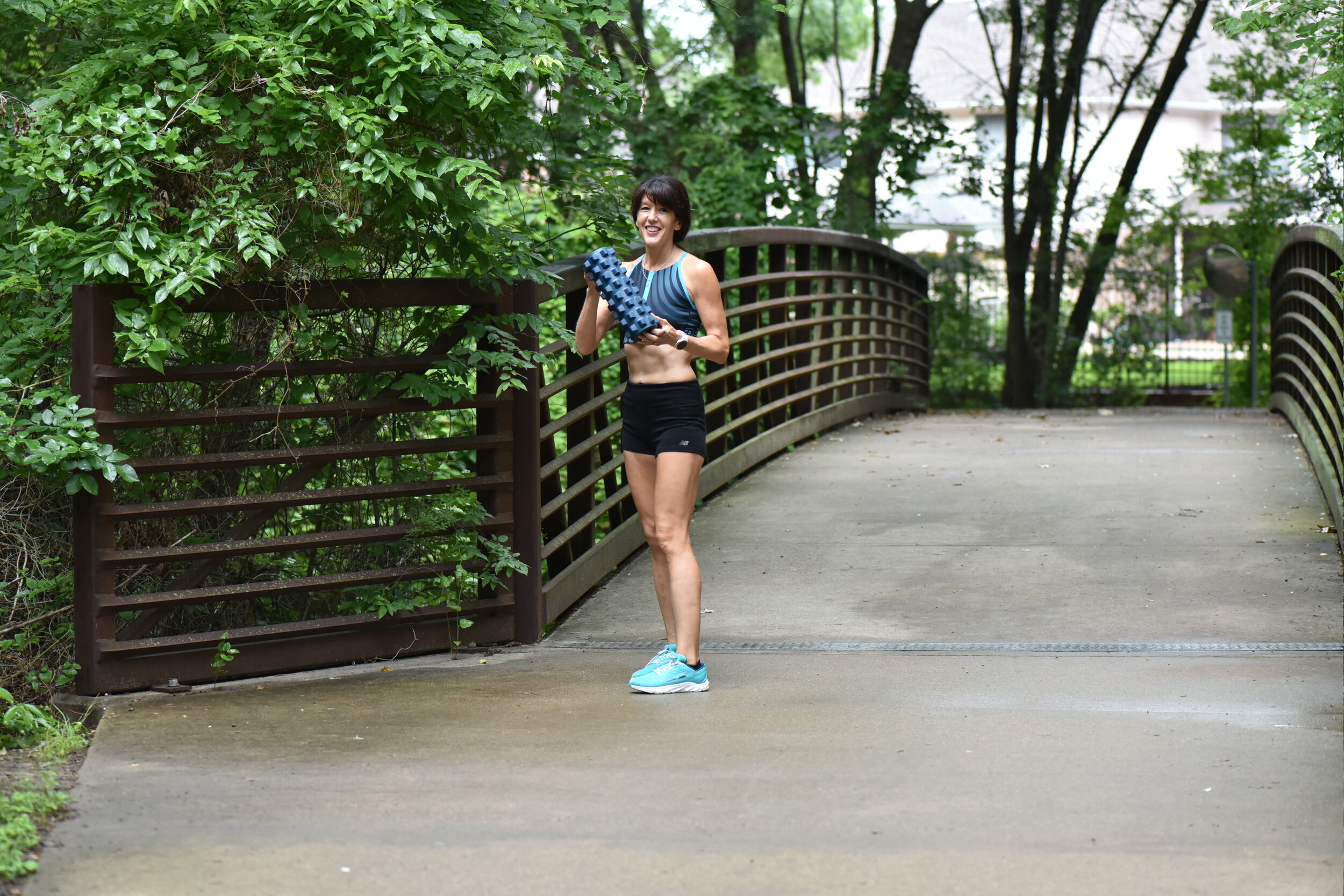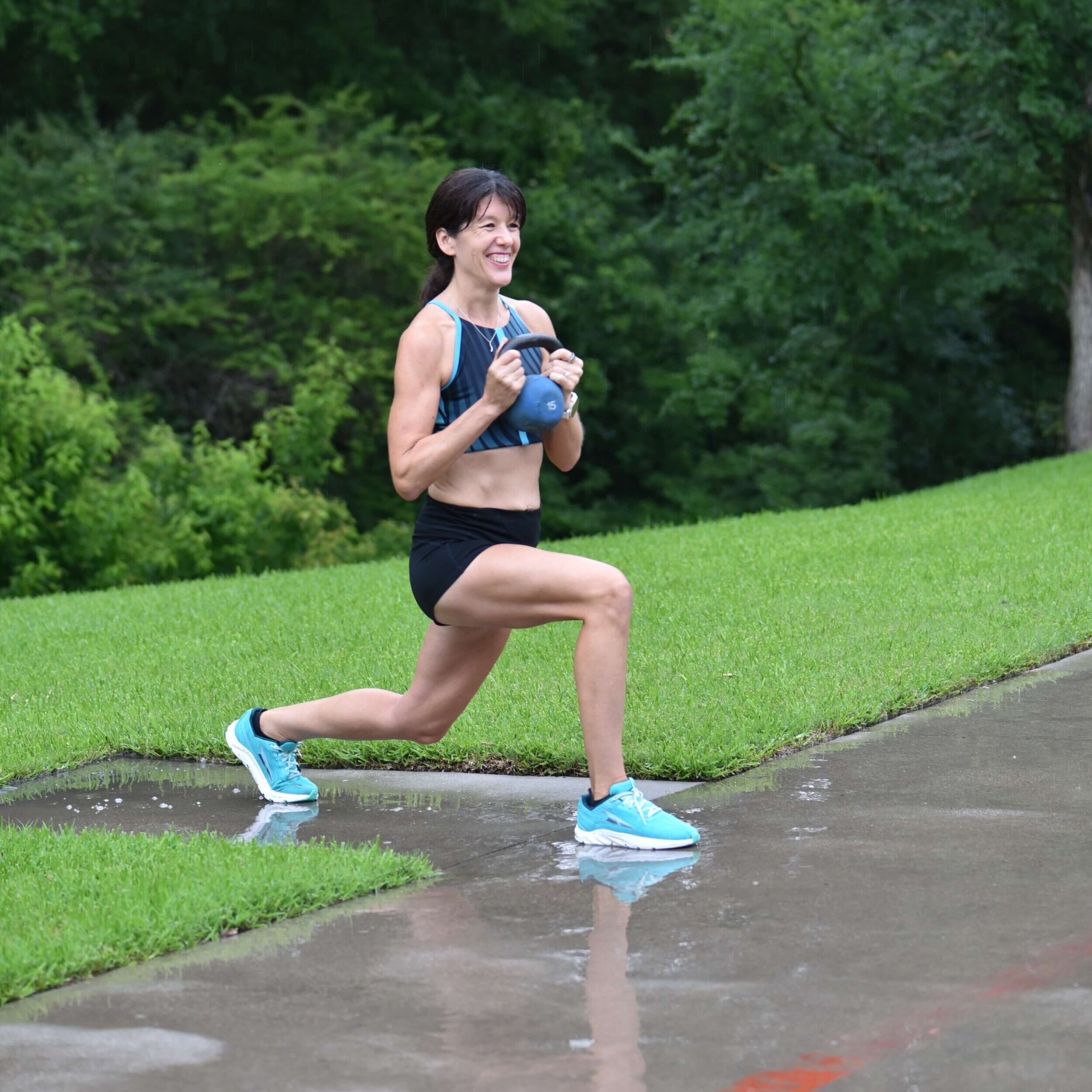Welcome to the latest edition of Workout Wednesday when each week I share a new running or strength training for runners workout.
This week we are focusing on unilateral strength, that means working on one side at a time. When we run we repeatedly balance on one foot at a time for the duration of our workout. Building unilateral strength improves our running performance and helps to avoid muscle imbalances that can lead to injury.
These exercises just require one dumbell. I recommend an 8 to 12 pound dumbbell to start.
Move through each exercise in a circuit style. Complete the reps assigned and move on the next exercise with little to no rest. Move quickly, but go slow enough to maintain proper form. This is not a race against the clock. Once you complete all eight exercises on both sides, rest for a minute and repeat the circuit one or two more times.
PLANK ROWS
A plank row is an effective exercise for runners. A plank requires core stability and the row movement with a dumbbell builds strong back muscles. A runner needs a strong back to power the stride and maintain running form over long distances. This is a tough move that will build runner-specific strength and stability in the core/back.
Start in a straight-arm high plank position with your wrists directly under your shoulders and your legs slightly wider than hip width for stability. Keep your body in a straight line from your shoulders to ankles while engaging your core. Do not allow your hips to hike up or sag down.
Hold a weight in one hand on the floor. With your core tight and your glutes engaged keep your elbow pointing up towards the ceiling and close to your side as you pull the weight up from the floor. Do not allow your body to rock as you row. Hold everything steady. Perform the reps on one side, then repeat on the opposite side.
ELBOW PLANK TO SIDE PLANK
The elbow plank to side plank exercise is a rotational core stabilization move. It's important for runners to have a strong core in all planes of motion to maintain proper running form and avoid imbalances.
Begin in a low forearm plank position. Position your elbows on the floor with your hands flat on the floor and your shoulders directly over your elbows. Do not clasp your hands in front of you. Your body should be in a straight line parallel to the floor. Engage your core, pulling in your belly while breathing normally. Be careful not to sink your hips or raise your butt in the air.
Twist to the right to move into a elbow side plank position keeping your right leg in front of your left for stability. Reach your arm to the ceiling and hold for 3-5 seconds before returning to plank position. Repeat on the right side for the assigned reps, then switch to the other side.
WEIGHTED SIDE LUNGE
Runners move in one plane of motion, forward, so it is important to build lateral strength in the frontal plane to avoid muscle imbalances that can lead to injury. This side lunge exercise strengthens the important but often overlooked gluteus medius muscle using a dumbbell on the opposing lunged side.
Face forward with toes pointing straight ahead, hold a weight in your left hand and take a wide step out to your right side. Push your hips back, bend your right knee while straightening your left leg. With your back straight and chest up, hinge at your hips to bring the weight in your left hand to touch the floor next to your right foot. Do not round your back or allow your knee to move forward beyond your toe. Be sure to keep your torso facing forward. Perform the assigned reps, then repeat on the other side.
SINGLE LEG LIFT AND CHOP
This is an effective balance and rotational exercise for runners. Building both balance and rotational strength is essential for runners.
Stand on your right leg with your knee soft (not locked) and grip the weight on each end with two hands. Reach your arms straight up over your right shoulder and slightly twist your torso to the right. Bring the weight across your body and down towards the outside of your left knee by rotating your torso and shoulders. Perform the reps then stand on the other leg and repeat on opposite side.
SINGLE LEG DEADLIFT
Building unilateral hip strength is highly beneficial for runners. The single leg deadlift builds single leg/hip strength and balance.
Standing on one leg, keep your knee slightly bent and perform a deadlift by hinging at your hip while keeping your back straight and neck neutral. Extend your free leg behind you in line with your body. Grip the weight on each side with two hands and lower until your back is parallel to the floor. With your back straight return to the upright position. Perform the reps on one side then repeat on other side.
STATIC LUNGE TO SINGLE ARM SHOULDER PRESS
Performing a single arm shoulder press in a kneeling lunge position requires core strength and stability. Get the most out of your workout by challenging your core while you perform the exercise.
With your feet hip width apart and your toes pointed straight ahead, engage your core and keep your back straight. Take one large step with your right leg to lunge forward until your front knee is lined up over your ankle and your back knee is on floor (in a "will you marry me" position). Do not allow your front knee to move forward over your toes. Resist the urge to lean forward or rest your arms on your thighs.
Once you are in the lunge position, hold the weight on the same side as your back kneeling leg. Press the weight from the shoulder to the ceiling by straightening your arm. Squeeze and hold your glute muscles (while breathing normally) as you raise your arm to press the weight up to the ceiling. Perform all of the reps on one side, return to standing, then lunge with the other leg and repeat the reps on the other side.
Give it a try and let me know it goes. Do you ever do runner-specific strength training? Questions? I'd love to help.
Like this post? It helps me when you share with your friends and followers.








































Runners who strength train are stronger, faster, and less injury-prone! While focusing on runner-specific exercises, I’ll show you the benefits of resistance training with one piece of equipment—a kettlebell. This program is five weeks of progressive workouts that take about thirty minutes each, two to three times per week.